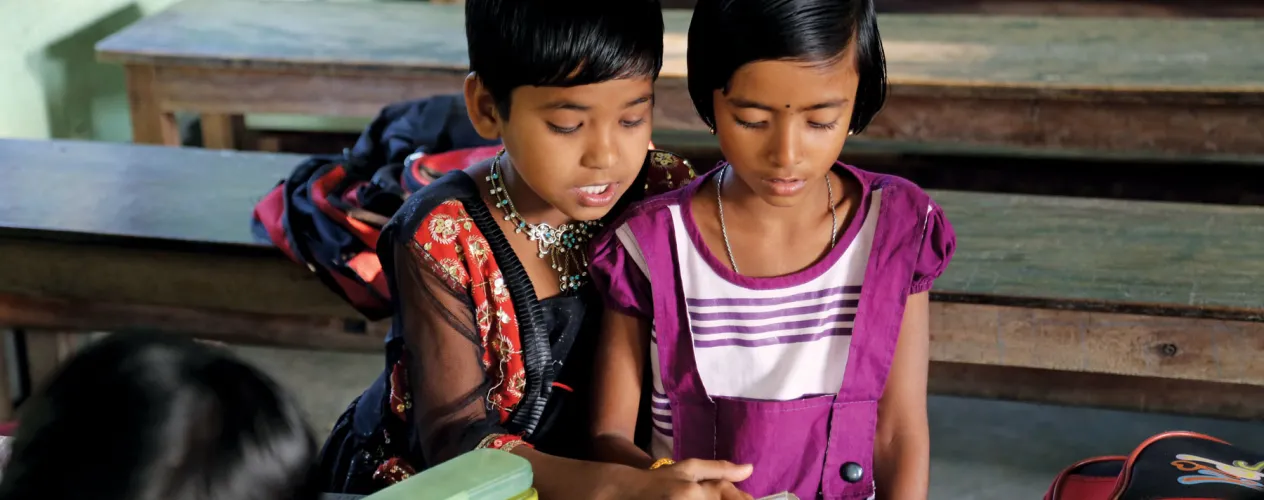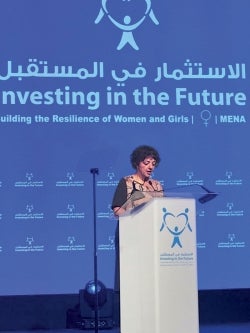Acting Globally
Alum Veronica Magar leads a WHO team that is taking innovative approaches to reducing inequities in health services worldwide.

At WHO we don’t look at human rights, equity or gender in isolation, but rather through an integrated framework.”
— Dr. Veronica Magar

Dr. Veronica Magar (MPH '91)
FUNDAMENTAL TO THE UNITED NATIONS SUSTAINABLE DEVELOPMENT GOALS (SDGs) — the 15-year agenda for a healthier, safer and fairer world by 2030 — is a commitment to health and well-being for all, gender equality, and the reduction of inequalities within and among countries. These goals are inextricably linked. “When women and girls are able to stay in school longer, plan or prevent pregnancies, and access health services without discrimination, they can improve their economic opportunities and ultimately transform their futures,” World Health Organization (WHO) Director-General Tedros Adhanom Ghebreyesus asserted in a statement issued on International Women’s Day 2018.
At the Geneva-based WHO, Dr. Veronica Magar (MPH ’91, MA)is a leader in efforts to meet the ambitious SDG targets. Magar heads WHO’s Gender, Equity and Human Rights team, which works at the country, regional and global levels to promote universal access to quality health services without barriers or discrimination. Her group has adopted innovative approaches that require stepping out of traditional comfort zones. “At WHO we don’t look at human rights, equity or gender in isolation, but rather through an integrated framework,” Magar says. “That means working across sectors bringing lawyers together with social epidemiologists and leaders of social movements, for example. It’s challenging, but it’s been effective.”
Raised in Los Angeles, Magar recalls being disturbed as early as high school by the inequalities around her, and determined to devote her life’s work to addressing them. She started her career as a hospital-based nurse, but soon discovered public health and became a public health nurse for Los Angeles County. While in that role, she became active with her union, serving on the negotiating committee during a time of labor strife. “That was a turning point in my becoming more interested and involved in the intersection between social movements and public health,” Magar says. Among other things, it brought her to the Fielding School, where she earned a joint MPH and MA in Latin American Studies.
At WHO, Magar’s team addresses discrimination and inequities both at the structural level, through policies and laws, and in the field. “Social and cultural norms can have a major health impact,” Magar explains. “If women aren’t being allowed to leave the house, or if someone of a lower caste can’t walk through the village to get to the health center, that’s an access problem. And this isn’t just about women. Social norms and expectations related to masculinity can be harmful to men.”
At least half of the world’s population — a disproportionate number of them women and girls — lack access to essential health services because they are either not available orare financially out of reach, according to the WHO. Nearly 100 million face extreme poverty because they must pay for health services out of their own pockets. Even where health coverage is provided, it often discriminates against women and girls by, for example, not offering contraception, which can lead to unplanned pregnancies that exacerbate gender inequalities. And although women and girls bear higher costs of inequality and disadvantage, Magar’s group also focuses on disparities that negatively affect males, including higher rates of health-risk behaviors such as alcohol and tobacco use. “Masculinity and being male can also negatively influence health outcomes,” she says. “We want to shift the narrative away from viewing gender in a binary way.”
The approaches Magar’s group takes to these and other concerns are both global and granular. The former includes last year’s joint UN/WHO 2017 statement on ending discrimination in health care settings; it also includes WHO’s Women on the Move report on the issue of care workers — largely migrant women in informal home settings who, despite their important public health contributions, are themselves exposed to health risks and access barriers while receiving few labor or social protections.
WHO’s Gender, Equity and Human Rights team has also engaged policymakers to ensure that women’s health is broadly addressed in the United Nations Commission on the Status of Women, the global intergovernmental body dedicated to the promotion of gender equality and female empowerment. “Veronica has addressed the issue of gender inequality and discrimination, bringing a passion to her work and a focus on social justice for the world’s women,” says Soon-Young Yoon, UN representative of the International Alliance of Women and former chair of the NGO Committee on the Status of Women.
On the ground, Magar’s team is targeting the hardest to reach populations. The Millennium Development Goals (MDGs), which were the precursors to the SDGs, focused on aggregate-level changes. “We were able to make a lot of difference with the MDGs, but there wasn’t enough attention to those who are left behind — including remote and indigenous populations, and others who face disadvantage and marginalization,” Magar says. “The SDGs mark a shift in that we are looking at inequalities not just across countries, but also within countries.”
The world is in a state of transition that has profound effects on women’s health, Magar notes. The expanding world economy resulting from globalization is generating more jobs for women while creating new opportunities to transform gender roles. But the work is not distributed equally, leading to growing health disparities. At the same time, a seismic epidemiologic shift is afoot. Of the six most common causes of death among women, five are non-communicable diseases (NCDs). “We need to move beyond the myths that women are defined only by their reproductive capacities; that NCDs, especially cardiovascular disease, primarily affect men; and that NCDs in women are an issue only in high-income countries and a result of lifestyle choices,” Magar says.
“The SDGs call us to action to tackle inequalities within and between nations. To do that, we need to go beyond reproductive health to encompass non-communicable diseases, universal health care, aging women, and health workforce gender issues, among others. And instead of a disease and biomedical focus, we must look at inequalities, focus on prevention, and promote policies and programs that not only help women survive, but enable them to live better.”